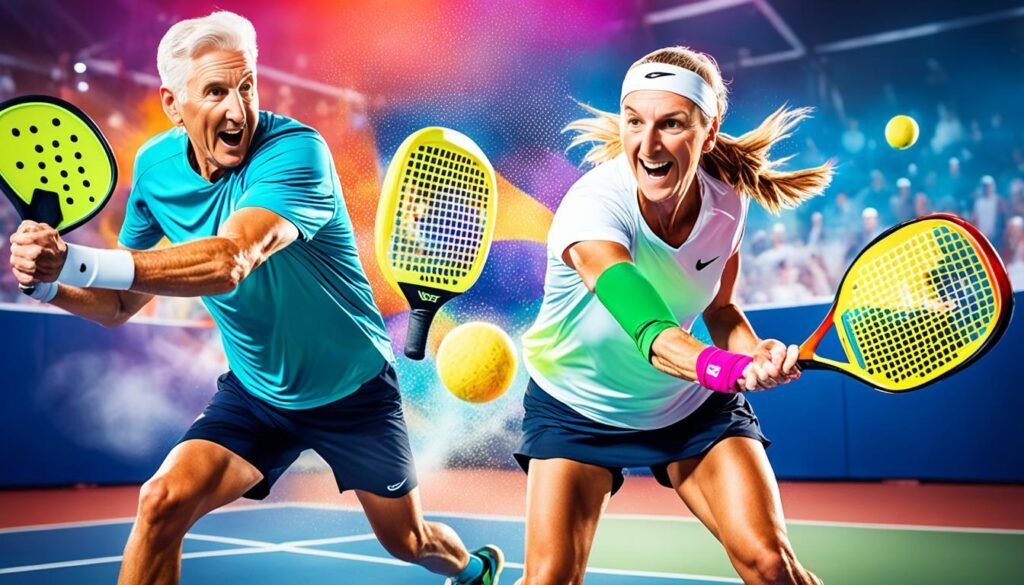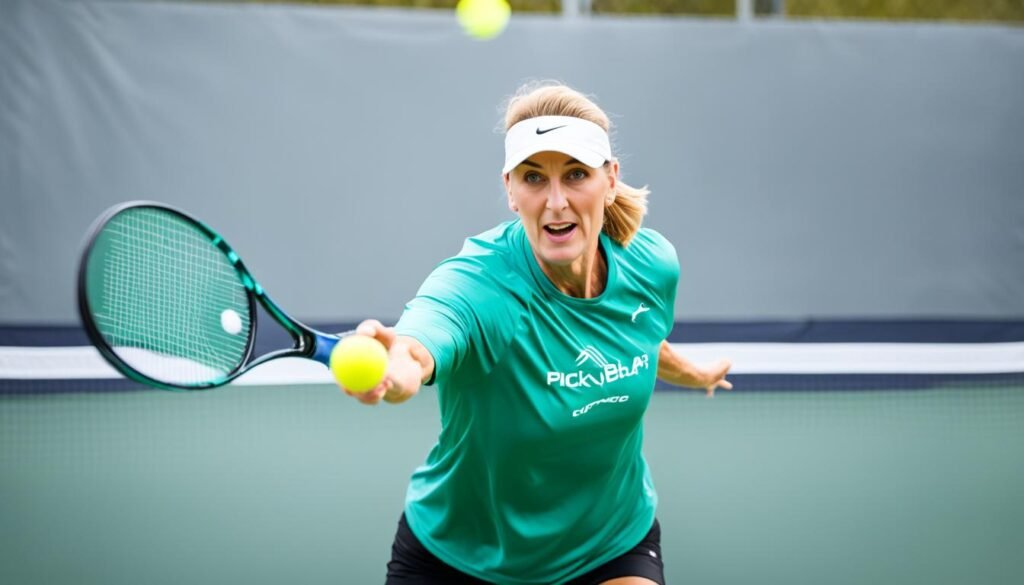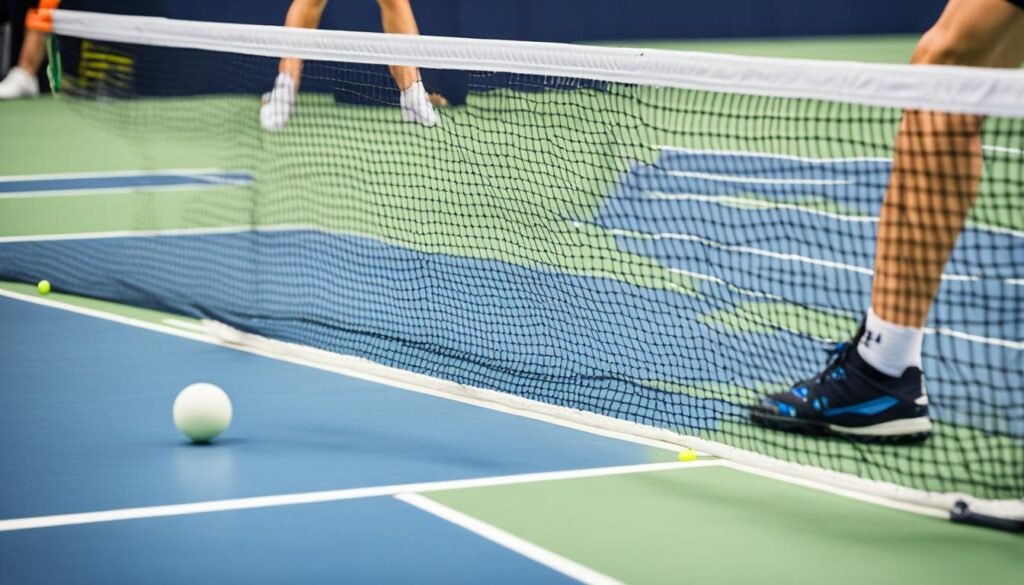Pickleball is quickly becoming a favorite in the U.S. With more than 3 million players, it combines aspects of tennis, table tennis, and badminton. Whether you’ve just started or are already playing, learning the important shots is vital. This helps to boost your game and advance your skills.
Key Takeaways:
- Mastering the essential shots is crucial for improving your pickleball game.
- The forehand, backhand, volley, and dink are key shots to focus on.
- Developing strategies and techniques through drills and training will help you improve.
Understanding Pickleball Shots: Strokes vs. Shots
Pickleball is a thrilling sport with many shots and techniques. It’s vital to know the difference between strokes and shots first.
A stroke is how you swing the paddle to hit the ball. It includes the basic moves and rules of the game. The shot is what happens after the stroke. For example, you might hit a forehand shot into the corner or a fast shot down the line.
Take the forehand stroke as an example. It’s the basic move to hit the ball. A forehand shot could be many things, like a drop shot or a powerful hit down the line. Knowing the stroke helps you use different shots effectively.
Learning basic strokes well is key. This helps you pull off various shots better. Now, let’s look at some basic shots in pickleball.
- Serve: Gets the game going and lets you set the pace.
- Lob: A shot that sends the ball high to give you more time or push your opponent back.
- Cross-court dink: A shot made close to the net that’s hard to return.
- Drive: Strikes the ball hard and fast, aiming to win the point.
- Block: A defensive move to counter fast shots safely.
- Third shot drop: A soft shot right over the net to gain control in the game.
As you practice these shots, you’ll get better and see how strokes and shots fit together. Remember, strokes are the base while shots show your playing style.
Mastering Principles for Effective Shots
To get better at pickleball, focus on key principles for great shots:
- Proper technique: Use the right grip, move your feet correctly, and position your body well for each hit.
- Focus on consistency: Aim to do each stroke the same every time. This improves your aim.
- Understanding shot selection: Know the best shot for each situation, considering where your opponent is.
- Controlled power: Balance between hitting the ball hard and hitting it accurately. This makes your shots better.
Use these principles in your game. They will help you improve and stand out on the court.
Stay tuned for the next section as we explore the basic shots in pickleball in more detail.
Basic Shots in Pickleball
Pickleball has a few key shots that every player should learn. Each shot has its own use and needs certain skills to pull off. Practicing these shots will help you get better and beat your opponents.
Serve
The serve starts each pickleball match. It’s really important because it sets the game’s rhythm. You need good technique for the serve, including where you stand and how you hold your paddle.
Lob
The lob can change a game fast. It sends the ball high and deep into the other court, hard to hit back. This shot needs careful aim to keep your opponents guessing.
Cross-Court Dink
A cross-court dink is a sneaky shot close to the net. It’s hit gently over the net at an angle. It makes your opponent move and opens up your chances for later plays.
Drive
A drive is a strong, attacking hit in pickleball. It makes your opponents rush to hit back. Good footwork and timing are key for a sharp drive.
Block
The block is for stopping hard-hit shots. You use it to send the ball back easily. This shot relies on quick thinking and being ready for your opponent’s moves.
Deep Return Serve
A deep return serve is hitting the ball far into the other court after their serve. It keeps your opponent from attacking right away. It takes good aim and timing to keep them guessing.
Backhand Punch
The backhand punch is a fast, powerful backhand shot. It’s good for hitting back fast shots and staying in control. Quick reactions and strong wrists are important here.
Overhead Smash
The overhead smash is for balls high above the net. It’s a very aggressive shot. Good timing and form are critical to make a winning smash.
Third Shot Drop
After the serve and return, the third shot drop is a soft hit. It goes just over the net and into the kitchen. The idea is to make your opponent hit up, where you have the advantage. This shot requires a lot of precision and control.
Dink Fake
A dink fake fools your opponent into a wrong move by looking like a dink. It’s all about deceptive moves. This opens a chance for a strong follow-up shot.
Backspin Return Serve
The backspin serve makes the ball drop fast on your opponent’s side. It disrupts their play, putting them on the defense. To get a good backspin, you need to time it right and control your paddle well.
Around the Post Shot
The around the post shot is when you hit the ball from a very wide angle around the net post. It’s a hard shot for your opponent to return. You must be very precise and in the right spot to nail this shot.
Backhand Spin Dink
The backhand spin dink uses spin to make your hit unpredictable. It’s a great way to keep your opponent off balance. Using your wrist well and controlling the paddle causher
Push Shots and Hit Shots
Push shots are light and over the net, while hit shots are strong and fast. Knowing both helps you adjust to different parts of the game. It keeps your opponents guessing.
| Shot | Description |
|---|---|
| Serve | Starts the point by hitting the ball over the net into the diagonal service court. |
| Lob | Hit the ball high in the air and deep into your opponent’s court to create difficulty in returning. |
| Cross-Court Dink | Gently tap the ball over the net diagonally to outmaneuver your opponent and create strategic opportunities. |
| Drive | Hit the ball aggressively and with speed to put pressure on your opponents. |
| Block | Redirect your opponent’s aggressive shot back to their court with minimal effort. |
| Deep Return Serve | Return the opponent’s serve deep into their court to prevent quick attacks. |
| Backhand Punch | Execute a quick and powerful backhand shot to counter fast-paced shots. |
| Overhead Smash | Hit the ball with power and angle when it is high in the air, putting it out of your opponent’s reach. |
| Third Shot Drop | Play a soft shot just over the net and into the kitchen to force your opponents into defensive positions. |
| Dink Fake | Trick your opponent with deceptive body language and paddle positioning to create opportunities for aggressive shots. |
| Backspin Return Serve | Hit the ball with backspin to make it drop quickly after crossing the net, disrupting your opponent’s rhythm. |
| Around the Post Shot | Play a shot from an extreme angle around the net post, making it difficult for your opponent to reach. |
| Backhand Spin Dink | Use spin and touch with your backhand grip to create uncertainty for your opponent. |
| Push Shots and Hit Shots | Adapt to different game situations with gentle push shots or aggressive hit shots. |
Pickleball Strokes: Groundstrokes and Volleys
Learning different pickleball strokes is key to getting better at the sport. Two crucial strokes are groundstrokes and volleys.
Groundstrokes happen after the ball bounces once. You use a forehand or backhand grip based on your strong hand. The forehand groundstroke offers power and precision. And the backhand groundstroke is reliable for hitting balls from many angles.
Volleys are shots before the ball hits the ground, near the net. They need quick reflexes and good coordination. Volleys are powerful and fast, catching opponents off guard.
Visual info on groundstrokes and volleys is in the table below:
| Groundstrokes | Volleys | |
|---|---|---|
| Definition | Shots made after the ball bounces once | Shots made before the ball hits the ground |
| Execution | Forehand or backhand grip | Quick reflexes and good hand-eye coordination |
| Characteristics | Powerful and accurate | Played close to the net |
| Advantages | Allows for strong baseline shots | Gives less time for opponents to react |
Being good at both groundstrokes and volleys will make your game strong. With practice and the right technique, you can become a pickleball pro. Work hard, and you’ll master these skills.
The Serve: Starting the Point
The serve is the first shot in pickleball and begins the point. It’s your chance to get a head start and control the game. A key to winning is not just serving fast or with a lot of spin. It’s about placing the ball accurately. This can really give you an advantage.
Choosing the right grip is crucial for a good serve. You should pick one that feels good and helps you control the paddle. Trying grips like Eastern or Continental can lead you to the best one for you.
How you position your body is also very important in serving. Standing right can help you hit the ball harder and more precisely. Make sure to have your feet apart and face where you want to serve. This position makes your movement smooth and strong.
Place your serve wisely on the court to outsmart your opponent. Serving to corners or their weaker side can lead to game-winning mistakes. Always pick where to serve with a plan in mind.
Here’s an example of a pickleball serve placement table:
| Serve Placement | Description |
|---|---|
| Wide Serve | Serve towards the sideline to force your opponent to stretch and return from an uncomfortable position. |
| T-Serve | Serve towards the center of the court, aiming for the transition zone between the forehand and backhand of your opponent. |
| Body Serve | Serve towards your opponent’s body, making it challenging for them to return the ball effectively. |
| Short Serve | Serve closer to the net to catch your opponent off guard and force them to make a difficult, low return. |
Don’t forget to practice your pickleball serve a lot. This will make you more consistent and confident. Try different serving styles and placements. This will make your serve game strong, helping you win more games over time.
The Dink: A Finesse Shot
The dink is a finesse shot in pickleball. It’s hit softly at the net. This shot slows the game and surprises opponents expecting a fast play. Mastery comes from knowing how to stand, hold your paddle, and be precise.
When you get the dink right, it’s a game-changer. It’s not about power but about how gently you can put the ball over the net. This forces your rivals to scramble, making their next moves harder.
For the dink to work, you need the right position and balance. Stand near the net to guide your shot accurately. Also, keep your grip light for a soft hit.
Remember, you can’t step into the No Volley Zone when dinking. This is crucial to avoid faults. Knowing where you stand and keeping within the court’s boundaries is vital for successful dinks.
Being spot-on is crucial in dinking. Aim for the court’s edges to challenge opponents. Adding spin will make it even harder for them to return the ball.
Getting good at dinking needs practice. Watch your opponent, predict their next move, and adjust your dinks. This way, you keep your game unpredictable, which is key to winning.
The Drive: Powerful and Fast
The drive in pickleball is key. It can completely change the game. This shot is strong and quick, sending the ball hard at your opponent.
It can be a groundstroke or a volley. Either way, it puts a lot of pressure on the other player. By moving your feet well and being in the right spot, you can make each drive count.
Staying stable and aiming your body where you want the ball to go is crucial. This helps your shots break through your opponent’s defense.
Good footwork is a must for a great drive. Move fast and get ready for the shot. Setting up correctly helps you hit the ball at its fastest.
When you swing, shift your weight forward. This lets you put your whole body into the shot. It makes your drive harder to return.
Hold your paddle firm for a good drive. A strong grip helps control the ball. Then, you can place your shot exactly how you imagined.
Learning the drive takes time and practice. Do lots of drills on footwork and how to hit the ball. This will make you great at the drive shot.
But remember, it’s not just about hitting hard. It’s about being both strong and precise. By working on your drive, you can really stand out in pickleball.
Improve your drive over time. It will be a key skill in winning your pickleball games.
The Lob: A Strategic Shot
The lob shot in pickleball is a smart move. It can give you the upper hand over rivals. This shot sends the ball high and over their heads.
Here’s what makes a good lob: you need the right technique, backspin, and aim. These things make the lob effective.
For a great lob, focus on giving the ball backspin. This makes it go higher and buys you more time. Aim for the deep corners too, to make the most of your shot.
The lob isn’t just about scoring. It’s a strategy to make your opponents step back. This lets you open the court for a winning shot. It also keeps them moving and adjusting.
- Pickleball lob: A high shot played over the opponents’ heads.
- Lob shot: The act of hitting the ball high and deep.
- Placement: Strategically aiming the lob to specific areas of the court.
- Backspin: The spin on the ball that causes it to rotate backward, giving it a higher trajectory.
- Push opponents off the kitchen line: Forcing opponents to move away from the non-volley zone.
| Type | Advantages |
|---|---|
| Pickleball lob | 1. Pushes opponents back 2. Creates an opportunity to attack 3. Forces opponents out of their comfort zone |
| Lob shot | 1. Allows time to regain control of the point 2. Makes it difficult for opponents to return the ball 3. Sets up strategic positioning |
| Placement | 1. Targets deep corners to maximize effectiveness 2. Creates open court space 3. Forces opponents to cover more ground |
| Backspin | 1. Provides higher trajectory 2. Increases time to react 3. Makes it challenging to return the ball |
| Push opponents off the kitchen line | 1. Changes opponents’ positioning 2. Limits their ability to attack the net 3. Creates vulnerability in their defense |
Using the lob well can change your game. It makes opponents unsure and disrupts their play. The lob shot puts you in charge of how fast the game goes.
Advanced Shots in Pickleball
Besides the basic pickleball shots, some are more advanced. These require extra skill. Learning these shots will boost your level of play.
Third Shot Drop
The third shot drop helps take back control after your opponents serve. Hit the ball softly and close to the net. This makes your opponents hit an upward shot. Execute it carefully with the right techniques.
Forehand Groundstroke
The forehand groundstroke is strong and played on the forehand side. After the ball bounces once, hit it. This shot needs good footwork, body position, and a smooth swing for power and accuracy. It helps you lead the game.
Backhand Groundstroke
The backhand groundstroke handles different shots well on the backhand side. It needs good footwork, body position, and a smooth swing. This shot is adaptable, allowing you control with precision.
Volley
The volley is played before the ball hits the ground, usually near the net. It needs quick reflexes, hand-eye coordination, and a firm, controlled touch. Mastery of the volley lets you take control and pressure your opponents.
Smash
The smash is a powerful, overhead shot aimed to hit the ball hard. It’s played against high lobs or weak returns. Good timing, power, and grip strength are needed. This shot can change the game, intimidating opponents and winning points.
Topspin
Topspin adds forward rotation to the ball, making it drop and bounce higher. This shot is good for groundstrokes and volleys. It makes it hard for opponents to return. Perfect your technique and wrist action for this effective shot.
Learning these advanced pickleball shots will level up your game and give you an edge over opponents. Practice, patience, and a drive to get better are key. Add these shots to your training to improve your game significantly.
Conclusion
Learning the key shots in pickleball is vital for your progress. You become a better player by knowing the shots and practicing them. Don’t forget the importance of the correct technique, quick feet, and smart moves when playing.
To get good at pickleball, practice and work hard. Every shot, like the strong drive or the finesse dink, needs skill. It takes time to master each shot, but it’s worth it. Build a strong base with basic shots. Then, add advanced skills to your game.
Begin your pickleball journey and keep learning. With practice, you will improve your game. Enjoy pickleball and strive to perfect the essential shots. Remember, becoming a master is a journey of constant learning, growth, and joy in the game.



